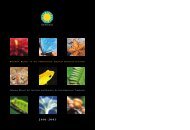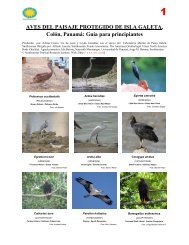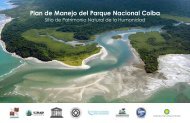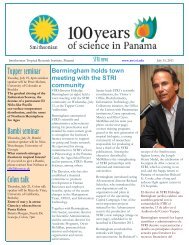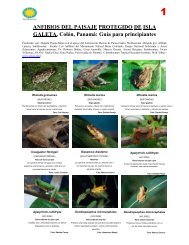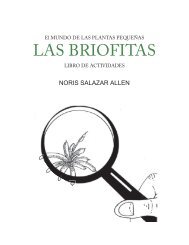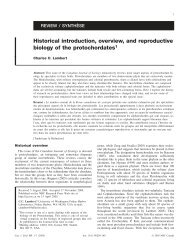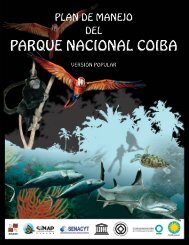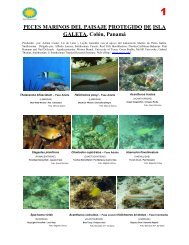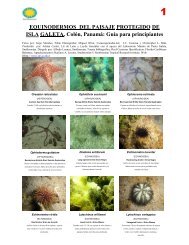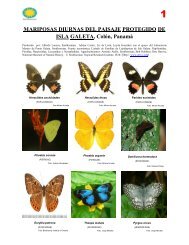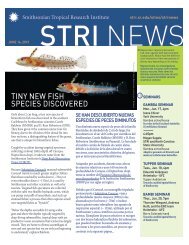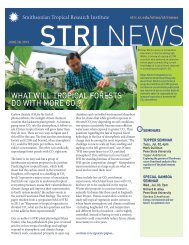Why do different butterfly species have similar wing patterns?
Why do different butterfly species have similar wing patterns?
Why do different butterfly species have similar wing patterns?
You also want an ePaper? Increase the reach of your titles
YUMPU automatically turns print PDFs into web optimized ePapers that Google loves.
stri.si.edu/sites/strinews<br />
MAY 18, 2012<br />
STRI NEWS<br />
Wing color <strong>patterns</strong> indicate that Heliconius<br />
butterflies taste bad.<br />
Los patrones de color en las alas de la mariposa<br />
Heliconius indican que ésta sabe mal.<br />
<strong>Why</strong> <strong>do</strong> <strong>different</strong><br />
<strong>butterfly</strong> <strong>species</strong> <strong>have</strong><br />
<strong>similar</strong> <strong>wing</strong> <strong>patterns</strong>?<br />
The Heliconius Genome<br />
Consortium* pooled funds to<br />
sequence the genome of the<br />
<strong>butterfly</strong> genus Heliconius,<br />
published in Nature this week.<br />
Panama’s Heliconius melpomene<br />
is a model for understanding how<br />
the stunning diversity of <strong>wing</strong><br />
color <strong>patterns</strong> in tropical butterflies<br />
evolved. “What we discovered<br />
is that one <strong>butterfly</strong> <strong>species</strong> can<br />
gain its protective colour pattern<br />
genes ready-made from a <strong>different</strong><br />
<strong>species</strong> by hybridizing with it,” said<br />
Kanchon Dasmahapatra, former<br />
STRI fellow.<br />
An analysis by Adriana Briscoe at<br />
the University of California showed<br />
that Heliconius has an even greater<br />
array of genes involved in chemical<br />
communication than moths, which<br />
depend on chemical signals for<br />
finding mates and host plants.<br />
The study heralds a new era in<br />
genome biology and an important<br />
step in the Smithsonian’s goal<br />
to understand and sustain a<br />
biodiverse planet. “Assembling a<br />
genome from scratch is still hard<br />
work: think Humpy-Dumpty,” said<br />
STRI’s Owen McMillan, “but it is<br />
getting easy, inexpensive, and is<br />
transforming how we <strong>do</strong> science.<br />
A reference genome opens up<br />
new research possibilities and<br />
reveals previously unimagined<br />
connections.”<br />
¿Por qué distintas<br />
e<strong>species</strong> de mariposas<br />
tienen patrones<br />
<strong>similar</strong>es en sus alas?<br />
El Heliconius Genome<br />
Consortium* recogió fon<strong>do</strong>s<br />
para secuenciar el genoma de la<br />
mariposa Heliconius publica<strong>do</strong> esta<br />
semana en la revista Nature. La<br />
Heliconius melpomene de Panamá<br />
es un modelo para comprender<br />
cómo evolucionaron los<br />
asombrosos y colori<strong>do</strong>s patrones de<br />
las alas de las mariposas tropicales.<br />
“Lo que hemos descubierto es que<br />
una especie de mariposa puede<br />
obtener genes de patrones de color<br />
protector ya listos de diferentes<br />
e<strong>species</strong> por cruzarse,” comenta<br />
Kanchon Dasmahapatra, antiguo<br />
becario del Smithsonian en<br />
Panamá.<br />
Un análisis realiza<strong>do</strong> por Adriana<br />
Briscoe de la University of<br />
California demostró que la<br />
Heliconius tiene una mayor<br />
Photo by Marcos Guerra<br />
colección de genes involucra<strong>do</strong>s<br />
en la comunicación química que<br />
las polillas, las cuales dependen de<br />
señales químicas para encontrar<br />
pareja y plantas hospederas.<br />
El estudio señala el comienzo de<br />
una nueva era en la biología de<br />
genomas y un paso importante<br />
en la meta del Smithsonian de<br />
comprender y sostener un planeta<br />
con biodiversidad. “Armar un<br />
genoma desde el principio es aun<br />
un trabajo arduo. Imagínese a<br />
Humpy-Dumpty,” comenta Owen<br />
McMillan del Smithsonian en<br />
Panamá, “pero se está hacien<strong>do</strong><br />
más fácil, menos costoso y está<br />
transforman<strong>do</strong> la manera en que<br />
hacemos ciencia. Un genoma<br />
de referencia nos abre nuevas<br />
oportunidades de investigación<br />
y nos revela conexiones previas<br />
inimaginadas.”<br />
*STRI, Panama: W. Owen McMillan; University of<br />
Cambridge, UK: Chris Jiggins; Boston University,<br />
USA: Sean Mullen; Harvard University, USA:<br />
Marcus Kronforst; University of California at Irvine,<br />
USA: Robert Reed, Adriana Briscoe; Muséum<br />
National d’Histoire Naturelle, Paris, France:<br />
Mathieu Joron; University of Edinburgh, UK:<br />
Mark Blaxter; University College Lon<strong>do</strong>n, UK, and<br />
Harvard University, USA: James Mallet; University<br />
of Exeter, UK: Richard ffrench-Constant<br />
The Heliconius Genome Consortium. Butterfly<br />
genome reveals promiscuous exchange of<br />
mimicry adaptations among <strong>species</strong>. 2012. Nature.<br />
Doi:10.1038/nature11041. Published online 16 May.<br />
SEMINARS<br />
gamboa seminar<br />
Mon., May 21, 4 pm<br />
Teague O’Mara<br />
STRI & Arizona<br />
State University<br />
Gamboa schoolhouse<br />
Ecological risk aversion and the<br />
development of ring-tailed lemur<br />
feeding ecology<br />
Behavior<br />
Discussion Group<br />
Tues., May 22, 2 pm<br />
Peter R. Marting<br />
PhD Student<br />
Arizona State University<br />
Tupper Large Meeting Room<br />
Testing for collective personality<br />
in Azteca ant colonies<br />
Tupper seminar<br />
Tues., May 22, 4 pm<br />
Mike Kaspari<br />
University of Oklahoma<br />
Tupper auditorium<br />
The ions of life--why sodium<br />
and potassium matter in tropical<br />
forest ecology<br />
ARRIVALS<br />
Marian Shaffer<br />
University of Wisconsin-Green Bay<br />
Field Course - INRC Internship<br />
Program - 2012<br />
Bocas del Toro, Naos Marine Lab<br />
Ana Magdalena Hurta<strong>do</strong><br />
Arizona State University<br />
Uso de antibioticos y<br />
comportamiento por hormigas<br />
cultiva<strong>do</strong>ras de hongos para<br />
evitar enfermedades infecciosas<br />
y parasitoides
ARRIVALS<br />
Matthew Fuxjager<br />
University of California - Los<br />
Angeles<br />
Hormonal and neural control<br />
of a sexually dimorphic behavior<br />
Naos Marine Lab<br />
Layla Freeborn<br />
Tulane University<br />
Phylogeography of Bocas del Toro<br />
Bocas del Toro<br />
Michael Weiser, Jackson Helms,<br />
Jelena Bujan, Michael Kaspari<br />
University of Oklahoma<br />
Experimental MacroEcology-the<br />
kinetics of biodiversity in soil<br />
microbes and invertebrates<br />
Barro Colora<strong>do</strong> Island (BCI)<br />
Julia Berkey, Daniel Lenger<br />
Tulane University<br />
Selection and the rapid evolution<br />
of morphological variation among<br />
Strawberry poison-dart frogs of<br />
the Bocas del Toro archipelago<br />
Bocas del Toro<br />
Sebastian Gottfried<br />
TU Dortmund<br />
Evolutionary ecology of fungus<br />
gro<strong>wing</strong> ants<br />
Barro Colora<strong>do</strong> Island (BCI)<br />
Kirsten Nicholson,<br />
Sarah Burton,<br />
John Phillips<br />
Central Michigan University<br />
David Laurencio<br />
Auburn University<br />
Systematics and biogeography<br />
of mainland Norops clade<br />
Anolis lizards<br />
Bocas del Toro, Fortuna, Barro<br />
Colora<strong>do</strong> Island (BCI), Gamboa<br />
Erik Lindquist<br />
Messiah College<br />
Molly Bletz<br />
James Madison University<br />
Investigations of the cutaneous<br />
microbial community<br />
of Isthmohyla pica<strong>do</strong>i:<br />
Determination of the presence<br />
of the anti-Bd bacteria<br />
Karen Lips<br />
University of Maryland<br />
Evolution of a<br />
mphibian MHC genes after an<br />
infectious disease outbreak “<br />
From left to right | De der. a izq.: Marco Neira, Néstor Sosa, Luke Alphey<br />
Fred Gould, Jennifer Kuzma y Carlos Gálvez.<br />
Open Forum:<br />
Transgenic<br />
Mosquitoes<br />
The Gorgas Memorial Institute<br />
of Tropical & Preventative<br />
Medicine, the University of<br />
Panama and the Smithsonian<br />
organized the forum:<br />
“Transgenic Mosquitoes:<br />
Where are we in Panama?” on<br />
May 16. The aim was to discuss<br />
the technology needed to<br />
produce transgenic insects and<br />
their use to control dengue,<br />
their applicability and the<br />
scientific studies needed to<br />
guarantee the efficacy of the<br />
method against this disease.<br />
Dengue, a serious and<br />
incurable disease, is produced<br />
by a virus transmitted by<br />
female mosquitoes, Aedes<br />
aegypti. In Latin America<br />
and the Caribbean dengue<br />
incidence and severity is<br />
rapidly increasing. In 2011<br />
Panama counted 3882 cases of<br />
dengue resulting in 16 deaths<br />
with costly ramifications for<br />
the health and economic<br />
sectors.<br />
During the forum, scientists<br />
presented advances in<br />
technologies under study<br />
for more than 10 years to<br />
create transgenic mosquitoes<br />
incapable of transmitting<br />
dengue virus, as well as<br />
creating male mosquitoes<br />
that mate with the females<br />
resulting in larvae that cannot<br />
reproduce.<br />
Foro Abierto:<br />
Mosquitos<br />
Transgénicos<br />
El Instituto Conmemorativo<br />
Gorgas de Estudios de la Salud,<br />
la Universidad de Panamá<br />
y el Smithsonian celebraron<br />
el Foro Abierto: “Mosquitos<br />
Transgénicos: ¿Dónde estamos<br />
en Panamá?” el 16 de mayo.<br />
El objetivo fue discutir<br />
la tecnología de insectos<br />
transgénicos para controlar el<br />
dengue, su aplicabilidad y los<br />
estudios científicos necesarios<br />
para garantizar su eficiencia<br />
contra esta enfermedad.<br />
El dengue, una enfermedad<br />
grave para la cual no existe<br />
un tratamiento específico es<br />
producida por un virus que se<br />
transmite por la hembra del<br />
mosquito Aedes aegypti. En<br />
América Latina y el Caribe, la<br />
incidencia y la gravedad de la<br />
enfermedad están aumentan<strong>do</strong><br />
rápidamente. En 2011 en<br />
Panamá se contabilizaron 3882<br />
casos de dengue que resultaron<br />
en 16 muertes y costosas<br />
implicaciones en los sectores<br />
salud y económico.<br />
Durante el foro, científicos<br />
destaca<strong>do</strong>s presentaron<br />
los últimos avances de las<br />
tecnologías estudiadas por<br />
más de 10 años que buscan<br />
crear mosquitos transgénicos<br />
incapaces de transmitir el virus<br />
del dengue, así como también<br />
crear machos que al aparearse<br />
con hembras hacen que estas<br />
produzcan larvas que mueren<br />
antes de desarrollarse.<br />
ARRIVALS<br />
Yonatan Munk<br />
University of Washington<br />
Dana Frederick,<br />
Samantha Nicholls<br />
University of Arkansas<br />
Ecology and behavior<br />
of arboreal arthropods<br />
Barro Colora<strong>do</strong> Island (BCI)<br />
Frederick Hanselmann<br />
Texas State University<br />
The lost ships of<br />
Henry Morgan project<br />
Galeta Station<br />
Jordan Bemmels, Na Wei<br />
University of Michigan<br />
Population genetic structure and<br />
phylogeography of widespread<br />
tropical forest trees<br />
Barro Colora<strong>do</strong> Island (BCI)<br />
Andrew Bretscher,<br />
Casey Krause<br />
Frostburg State University<br />
Influence of resource abundance<br />
on intra- and inter-specific<br />
interactions between the<br />
Echimyid Rodent Proechimys<br />
semispinosus and Hoplomys<br />
gymnurus<br />
Gamboa<br />
Jesse Delia<br />
Boston University<br />
Parent-embryo interactions<br />
in neotropical glassfrogs<br />
(Centrolenidae) - Amendment<br />
Gamboa<br />
Adam Kay<br />
University of St. Thomas<br />
Toward a stoichiometric theory<br />
of ant ecology--from colony<br />
performance to community<br />
composition<br />
Barro Colora<strong>do</strong> Island (BCI)<br />
Matthew Starr<br />
University of Louisiana at<br />
Lafayette<br />
“NSF IOS-1019727 - Biased<br />
evolutionary transitions in mode<br />
of development: Can differences<br />
in morphology and digestive<br />
function be linked to evolvability<br />
of gastropod development<br />
Naos Marine Lab
ARRIVALS<br />
Gladys Gonzalez Dufau<br />
Instituto de Investigacion<br />
Agropecuaria de Panama<br />
MMUL - Molecular Multiuser<br />
Laboratory<br />
Naos Marine Lab<br />
Robert Dudley<br />
University of California -<br />
Berkeley<br />
Ecophysiology of neotropical<br />
<strong>butterfly</strong> migrations<br />
Barro Colora<strong>do</strong> Island (BCI)<br />
DEPARTURES<br />
Harilaos Lessios<br />
To St. Petersburg, Florida<br />
To join research cruise organized<br />
by the University of Florida,<br />
Florida Institute of Technology.<br />
Rachel Collin<br />
To Bonaire<br />
To attend the Association of Marine<br />
Labs of the Caribbean Board meeting.<br />
Collin is currently the Director.<br />
NEW PUBLICATIONS<br />
Ackerman, James D. and Roubik,<br />
David Ward. 2012. Can extinction<br />
risk help explain plant–pollinator<br />
specificity among euglossine bee<br />
pollinated plants? Oikos, <strong>do</strong>i:DOI:<br />
10.1111/j.1600-0706.2011.20193<br />
Ayala, R. C., Bayona, G., Car<strong>do</strong>na,<br />
A., Ojeda, C., Montenegro, O.<br />
C., Montes, C., Valencia, V. and<br />
Jaramillo, C. 2012. The paleogene<br />
synorogenic succession in<br />
the northwestern Maracaibo<br />
block: Tracking intraplate<br />
uplifts and changes in sediment<br />
delivery systems. Journal of<br />
South American Earth Sciences,<br />
<strong>do</strong>i:10.1016/j.jsames.2012.04.005<br />
Becker, Nina I., Encarnação,<br />
Jorge A., Kalko, Elisabeth K.<br />
V. and Tschapka, Marco. 2012.<br />
The effects of reproductive state<br />
on digestive efficiency in three<br />
sympatric bat <strong>species</strong> of the same<br />
guild. Comparative Biochemistry<br />
and Physiology - Part A: Molecular<br />
& Integrative Physiology,<br />
<strong>do</strong>i:10.1016/j.cbpa.2012.04.021<br />
Photo courtesy of Chris Freeman<br />
Chris Freeman<br />
Receives<br />
Research Award<br />
Chris Freeman, former fellow<br />
at STRI’s Bocas del Toro<br />
Research Station, was honored<br />
for his research on the mutually<br />
beneficial relationships between<br />
microorganisms and the reef<br />
sponges they live in.<br />
Freeman won the Dean’s Award of<br />
the College of Arts and Sciences<br />
at the University of Alabama at<br />
Birmingham, an annual award for<br />
distinguished research.<br />
A PhD candidate at UAB,<br />
Freeman attended the sponge<br />
taxonomy and ecology course at<br />
Bocas in 2006 and returned as<br />
a STRI fellow in 2010, when he<br />
completed most of the fieldwork<br />
for his dissertation.<br />
He already has a post<strong>do</strong>ctoral<br />
fellowship in hand at the<br />
Smithsonian Marine Station at<br />
Fort Pierce, Florida. Beginning<br />
in January, he’ll study the human<br />
impact on these symbiotic<br />
relationships in the Caribbean.<br />
“My experiences at the Bocas<br />
Station and with the Smithsonian<br />
<strong>have</strong> truly been instrumental in<br />
my development as a scientist<br />
over the last six years,”<br />
says Freeman.<br />
“Mi experiencia en la Estación<br />
en Bocas y con el Smithsonian<br />
realmente fue decisiva en mi<br />
desarrollo como científico en<br />
estos seis años,”<br />
comenta Freeman.<br />
Chris Freeman recibe<br />
premio por investigación<br />
Chris Freeman, antiguo becario<br />
en la Estación de Investigación<br />
del Smithsonian en Bocas del<br />
Toro, Panamá fue distingui<strong>do</strong> por<br />
su investigación referente a las<br />
relaciones mutualistas beneficiosas<br />
entre los microorganismos y las<br />
esponjas de arrecife en las que<br />
éstos habitan.<br />
Freeman ganó el Dean’s Award of<br />
the College of Arts and Sciences<br />
en la University of Alabama<br />
(UAB por sus siglas en inglés)<br />
en Birmingham, EEUU, premio<br />
anual otorga<strong>do</strong> por investigación<br />
ejemplar.<br />
Como candidato a <strong>do</strong>ctora<strong>do</strong> de<br />
la UAB, Freeman participó en los<br />
cursos de taxonomía y ecología<br />
en Bocas en el 2006 y volvió al<br />
Smithsonian como becario en el<br />
2010 al terminar la mayor parte de<br />
su trabajo de campo para su tesis.<br />
Él ya cuenta con una beca post<br />
<strong>do</strong>ctoral en la Smithsonian<br />
Marine Station en Florida, EEUU.<br />
A partir de enero, estudiará<br />
el impacto humano en estas<br />
relaciones simbióticas en el Caribe.<br />
Photo courtesy of Chris Freeman<br />
NEW PUBLICATIONS<br />
Beckman, Noelle G., Neuhauser,<br />
Claudia and Muller-Landau,<br />
Helene C. 2012. The interacting<br />
effects of clumped seed dispersal<br />
and distance- and densitydependent<br />
mortality on seedling<br />
recruitment <strong>patterns</strong>. Journal<br />
of Ecology, <strong>do</strong>i:10.1111/j.1365-<br />
2745.2012.01978.x<br />
Collin, R. 2012. Nontraditional<br />
Life-History Choices: What<br />
Can “Intermediates” Tell Us<br />
about Evolutionary Transitions<br />
between Modes of Invertebrate<br />
Development? Integrative and<br />
Comparative Biology <strong>do</strong>i: 10.1093/<br />
icb/ics065<br />
Díaz, Giovanny J., Rico, Jhon,<br />
Bayona, German, Montes, Camilo,<br />
Rosero, Alexis and Sierra, Daniel.<br />
2012. Analysis of curved folds<br />
and fault/fold terminations in<br />
the southern Upper Magdalena<br />
Valley of Colombia. Journal of<br />
South American Earth Sciences,<br />
<strong>do</strong>i:10.1016/j.jsames.2012.04.006<br />
Hecka<strong>do</strong>n-Moreno, Stanley.<br />
2012. Armage<strong>do</strong>n Hartmann:<br />
los campesinos chiricanos y la<br />
Guardia, 1968. Epocas, 27(4):<br />
10-11.<br />
Hirsch, B.T., R. Kays & P.A. Jansen<br />
2012. A telemetric thread tag for<br />
tracking seed dispersal by scatterhoarding<br />
rodents. Plant Ecology.<br />
<strong>do</strong>i: 10.1007/s11258-012-0054-0.<br />
Jung, Kirsten, Kaiser, Sonja,<br />
Boehm, Stefan, Nieschulze,<br />
Jens and Kalko, Elisabeth<br />
K. V. 2012. Moving in three<br />
dimensions: effects of structural<br />
complexity on occurrence<br />
and activity of insectivorous<br />
bats in managed forest stands.<br />
Journal of Applied Ecology, 49(2):<br />
523-531. <strong>do</strong>i:10.1111/j.1365-<br />
2664.2012.02116.x<br />
Rosindell, J., P.A. Jansen, R.S.<br />
Etienne. 2012. Age structure<br />
in neutral theory resolves<br />
inconsistencies related to<br />
reproductive size threshold.<br />
Journal of Plant Ecology 5: 64-71.<br />
<strong>do</strong>i: 10.1093/jpe/rtr034
May Dixon<br />
At 5 pm in Gamboa, not far<br />
from the Panama Canal, the<br />
playground is crowded with<br />
kids. Next <strong>do</strong>or, May Dixon is<br />
getting ready to mist-net bats.<br />
A recent graduate of Carlton<br />
College, May came to Gamboa<br />
as field technician for staff<br />
scientist, Rachel Page. “I<br />
already had rabies shots,” said<br />
the self-described wild woman,<br />
who’s caught hundreds of bats<br />
in the month that she’s been<br />
here. “In New England where<br />
I’m from there are only two<br />
<strong>species</strong> of bats but here in<br />
Panama there are around 120<br />
<strong>species</strong>.”<br />
At the forest’s edge, May sets<br />
up what looks like a badminton<br />
net made with very fine, black<br />
nylon thread. Only an hour<br />
after dark, a bat that she has<br />
never seen before summersaults<br />
into the net. “It’s a boy. It’s<br />
probably an insect eater that<br />
uses passive listening because it<br />
has long ears. Its broad <strong>wing</strong>s<br />
mean that it’s probably good at<br />
maneuvering.”<br />
Micronycteris hirsuta, the<br />
Hairy Big-Eared Bat, with<br />
its mohawk-like tuft of hair,<br />
is not the coolest bat she’s<br />
caught so far. That was a Great<br />
Wooly False Vampire on Barro<br />
Colora<strong>do</strong> Island! “It was a little<br />
bit terrifying.”<br />
May Dixon<br />
En Gamboa, a las 5 de la<br />
tarde, no muy lejos del Canal<br />
de Panamá los niños juegan<br />
en el parque. Muy cerca May<br />
Dixon se prepara para atrapar<br />
murciélagos con redes de<br />
niebla.<br />
May, recién graduada del<br />
Carlton College en Minnesota,<br />
EEUU, llegó a Gamboa como<br />
asistente de campo para Rachel<br />
Page, científica de planta del<br />
Smithsonian. “Ya me inyecté<br />
contra la rabia,” comenta May,<br />
que ha atrapa<strong>do</strong> a cientos de<br />
murciélagos durante el mes<br />
que ha esta<strong>do</strong> aquí. “En New<br />
England de <strong>do</strong>nde vengo,<br />
sólo hay <strong>do</strong>s e<strong>species</strong>, pero en<br />
Panamá hay alrede<strong>do</strong>r de 120<br />
e<strong>species</strong>.”<br />
A la orilla del bosque, May<br />
instala lo que parece una red<br />
de bádminton hecha de fino<br />
hilo de nylon negro. Una hora<br />
después del anochecer, cae<br />
en la red un murciélago que<br />
ella nunca había visto. “Es<br />
un macho. Probablemente se<br />
alimenta de insectos por medio<br />
de la escucha pasiva pues tiene<br />
orejas largas. Sus amplias alas<br />
significan que probablemente<br />
es bueno maniobran<strong>do</strong>.”<br />
El Micronycteris hirsuta,<br />
murciélago pelu<strong>do</strong> de grandes<br />
orejas y con un mechón de<br />
pelos estilo “mohawk” no es el<br />
murciélago más interesante que<br />
May haya atrapa<strong>do</strong>. Ese fue un<br />
gran vampiro falso pelu<strong>do</strong> en la<br />
isla Barro Colora<strong>do</strong> “Me aterró<br />
un poco.”<br />
Questions/comments<br />
Preguntas/comentarios<br />
STRINews@si.edu<br />
Photo by Pamela Belding<br />
May Dixon carefully untangles a bat captured<br />
in a mist net.<br />
May Dixon desenreda cuida<strong>do</strong>samente a un<br />
murciélago enreda<strong>do</strong> en una red de niebla.



